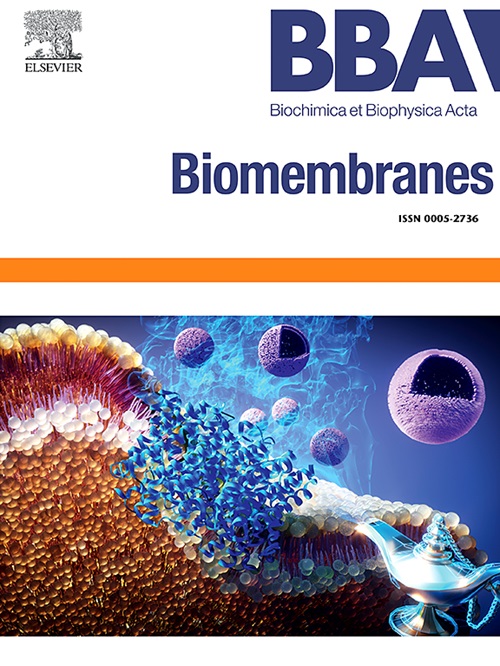An advanced spectroscopic and crystallographic study on a synergistic composition of a 1,3,4-thiadiazole derivative and amphotericin B, in model biological liposomal system
IF 2.5
3区 生物学
Q3 BIOCHEMISTRY & MOLECULAR BIOLOGY
引用次数: 0
Abstract
The paper presents the results of the first spectroscopic, microcalorimetric, and crystallographic study analyzing in great detail the strongly synergistic composition containing a selected 1,3,4-thiadiazole derivative: 4-(5-methyl-1,3,4-thiadiazol-2-ylo)benzene-1,3-diol (C1) and the antibiotic amphotericin B (AmB) in model biological DPPC films additionally modified with sterols: cholesterol (Chol) and ergosterol (Erg). The spectroscopic properties of the analyzed composition were studied with the use of spectroscopic methods, including: measurements of electronic fluorescence and absorption spectra with the technique of resonance light scattering (RLS), measurements of stationary fluorescence anisotropy and time-resolved fluorescence lifetimes with the method of single photon counting (TCSPC), circular dichroism spectra (CD), and infrared FTIR spectra. The mentioned methods were further complemented by including microcalorimetric DSC and crystallographic XRD analyses. All the measurements were taken in model biological systems formed as liposomal films and liposomal multilayers composed of DPPC and/or modified with sterols: cholesterol and ergosterol. The absorption spectra measured for C1/AmB and the synergistic composition thereof revealed differences indicating that while the antibiotic forms retained its known tendency to form aggregate in film systems, the synergistic composition had certain effects on the aggregational equilibrium. This was also reflected in the fluorescence emission measured for said systems, in particular the RLS and CD spectra, as well as, to an extent, the results of fluorescence anisotropy measurements. As we proceeded to the analysis of FTIR spectra, it was observed that the synergistic composition of C1 + AmB showed stronger interaction with the hydrophobic layer of the film. In turn, the crystallographic measurements performed for the synergistic composition revealed its impact on the multilayer's thickness. Finally, microcalorimetric measurements indicated that the synergistic composition had a lesser impact on the main phase transition temperature of the lipid, as compared to the respective compounds tested separately. The presented paper is the most detailed report to date pertaining to the synergism observed for the relevant systems analyzed in model biological films modified with sterols.
The study provides an in-depth spectroscopic, microcalorimetric, and crystallographic description of the molecular interactions analyzed for said molecular systems in model films formed of DPPC with the addition of sterols. Its results are particularly significant given the fact that AmB continues to be a clinically relevant antibiotic employed in the treatment of particularly severe internal mycoses and against otherwise resistant fungal strains.

1,3,4-噻二唑衍生物与两性霉素B在模型生物脂质体系统中协同组成的先进光谱和晶体学研究
本文介绍了第一次光谱、微量热和晶体学研究的结果,详细分析了模型生物DPPC膜中含有1,3,4-噻二唑衍生物4-(5-甲基-1,3,4-噻二唑-2-基)苯-1,3-二醇(C1)和抗生素两性霉素B (AmB)的强增效成分,另外还修饰了固醇:胆固醇(Chol)和麦角甾醇(Erg)。利用光谱学方法,包括:用共振光散射(RLS)技术测量电子荧光和吸收光谱,用单光子计数(TCSPC)方法测量稳态荧光各向异性和时间分辨荧光寿命,用圆二色光谱(CD)和红外傅立叶红外光谱(FTIR)方法测量被分析成分的光谱特性。采用微量量热DSC和晶体XRD分析进一步补充了上述方法。所有的测量都是在由DPPC和/或用甾醇(胆固醇和麦角甾醇)修饰的脂质体膜和脂质体多层形成的模型生物系统中进行的。测定的C1/AmB及其协同成分的吸收光谱显示出差异,表明虽然抗生素形式保留了已知的在膜系统中形成聚集的倾向,但协同成分对聚集平衡有一定的影响。这也反映在所述系统的荧光发射测量中,特别是RLS和CD光谱,以及荧光各向异性测量的结果中。随着FTIR光谱的分析,我们观察到C1 + AmB的协同成分与膜的疏水层表现出更强的相互作用。反过来,对协同成分进行的晶体学测量揭示了它对多层膜厚度的影响。最后,微量热测量表明,与单独测试的各自化合物相比,协同成分对脂质主要相变温度的影响较小。这篇论文是迄今为止关于在用甾醇修饰的模型生物膜中观察到的相关系统的协同作用的最详细的报告。该研究提供了深入的光谱、微量热和晶体学描述,分析了DPPC与添加甾醇形成的模型膜中所述分子系统的分子相互作用。鉴于AmB仍然是一种临床相关抗生素,用于治疗特别严重的内部真菌病和对抗其他耐药真菌菌株,其结果尤其重要。
本文章由计算机程序翻译,如有差异,请以英文原文为准。
求助全文
约1分钟内获得全文
求助全文
来源期刊

Biochimica et biophysica acta. Biomembranes
生物-生化与分子生物学
CiteScore
8.20
自引率
5.90%
发文量
175
审稿时长
2.3 months
期刊介绍:
BBA Biomembranes has its main focus on membrane structure, function and biomolecular organization, membrane proteins, receptors, channels and anchors, fluidity and composition, model membranes and liposomes, membrane surface studies and ligand interactions, transport studies, and membrane dynamics.
 求助内容:
求助内容: 应助结果提醒方式:
应助结果提醒方式:


